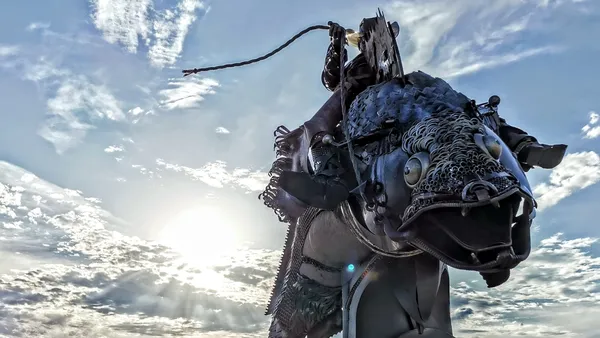 |
| A sculpture by John Lopez Photo: Lisa Ferguson |
Stacey Tenenbaum is sitting in her house with a raging ice storm outside when we connect to discuss her new documentary, Scrap. She tells me that a million people caught in it are without power, but so far, she’s okay. It’s another of those big events which put our individual lives in perspective. Stacey’s film broadens the perspectives of its viewers. It has questions to ask about big things: objects, vehicles, machines. What happens to them after they reach the end of their useful lives?
“Many, many years ago, when I was doing work on another project, I saw this photo that was kind of like a space junk aeroplane graveyard outside of Moscow. I was just like, ‘Wow, it's beautiful!’ And it completely captured my imagination – all the history that's there. It had this ghostly feel and I just loved it. So then I started thinking ‘Well, what happens to stuff?’ We all know about recycling in our homes, but what happens to these big things? So that was the genesis of the project.
 |
| An aeroplane graveyard in Bangkok Photo: Stacey Tenenbaum |
“We never really think about where things go. Phone boxes are a perfect example. They used to be on every corner, and then they kind of disappeared. I mean, not as much in London, but definitely here. Where did they go? And then I started researching and found that there were these sort of graveyards of things all around the world.
“I did a lot of research. It took really long time. At first I started just looking for the graveyards, and I found out there are these urban explorers who share my love of these places. So I started just looking on the internet and on Instagram and figuring out where this stuff ended up, but I knew I also wanted a human story in each place. That was the second level of figuring out who I could follow – who the person was that was going to lead us into this world, and what they had to say. That narrowed down my choices.
“Some of the things I knew I wanted to include. I knew I wanted to find people that were upcycling, taking these old things and making something new and beautiful. So at a certain point, I started looking for scrap metal artists. I had no idea, but that's also a thing. There are a lot of people all around the world doing really cool art with scrap metal. And John Lopez, the guy who ended up in the film, his art, I felt, was really head and shoulders above a lot of the other stuff out there. And then I spoke to him and he shared a lot of the feelings that I had about this stuff.
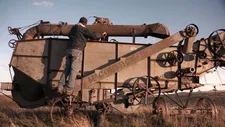 |
| Artist John Lopez exploring a piece of old farm equipment Photo: Katerine Giguère |
“The architect who makes buildings out of ships, I just came across a photo of that - it's actually in the film, it's the ship with these trees growing out of it. That was his first ship project. I just called him out of the blue and I was like, ‘Hey, are you planning to do anything else?’ And he was like, ‘Yes, I'm just starting in on this church.’ And so it happened that his timeline really, really worked well with my timeline.”
We talk about the film’s opening story, a car graveyard in which trees grow through old wrecks, and how it creates a sense of past and future, addressing what objects have been and what they are becoming.
“I think that part of it was looking at our connection to things,” she says. “I was looking for people who are deeply connected to the things that I was also showing, and that guy who has the car graveyard, he was born there and grew up there and he still lives in this place. Part of what I wanted to show is the nostalgia that can be related to these things – especially with cars. I think that people really identify with cars. It's like, ‘Oh, I had my first date in this car,’ or ‘When I got married, I was in that car.’ There's a lot of memory wrapped up in things.
‘The film moves from the cars just sinking back into the earth and moves from a graveyard to people who are reusing stuff, so it's not dying, and so the things are being reborn. So the arc of the film is, you know, we start with death and then maybe have rebirth at the end.”
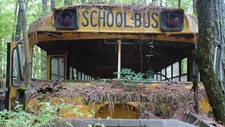 |
| A rusting school bus in Georgia Photo: Parker Lewis |
I note that there's the interesting section where we meet women who are taking apart electronic goods and extracting things from them. We see a lot of stories focused on exploitation of workers doing that kind of thing, and how waste is shipped from richer countries to poorer ones, but this seems to be a little bit different because those people are so proud of their work and so glad to have that opportunity.
“It's surprising, actually. I mean, they were really happy and they wanted to have us take their pictures. And so that was kind of interesting. There were segments where the photographer did talk to the workers about their lives and stuff, and they were happy to be supporting their families and sending their kids to school. Everyone who watches it will see it's a horrible atmosphere that they're working in, as you obviously get all kinds of dust and particles in the air that are not good for them. But at the end of the day, like all mothers, I guess they're working to create better lives for their kids.
“It was a pretty staggering place, that waste factory. Just to look at the huge amount of waste that we create. And like that factory is just a tiny, tiny, tiny sliver of what is being created just in India. It's staggering when you when you think about it.”
Factories are still managing to recycle only a tiny amount of that waste.
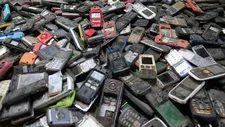 |
| Old phones delivered to E-Waste Delhi Photo: Anuj Singh |
“In India, just with the number of people there, the rate of waste is increasing exponentially. They actually have two sectors in India. One is an illegal sector, which is where they just burn everything, and it's extremely tough and extremely polluting. And the place that I went to India to film is actually part of the new official, safer, cleaner way of recycling in India. They're having trouble convincing people to give them their e-waste, just because they're used to throwing it in the street or getting these illegal vendors to come and pick it up. So yeah, it's a huge problem.
“The film doesn't have a very heavy handed environmental message but I think at the end, the whole point is that we have to try and figure out ways to use less for longer, to extend the life of the things that we use, to repair, to buy things that are well made. So I hope that that does come through.”
Her previous film, Shiners, looked at the shoe shining industry. Does she have a particular interest in telling the stories of workers whose voices we don’t often hear?
“Exactly, yeah. And actually, shoe shining also has a very similar environmental message, because, you know, people who buy really well made leather shoes, you can get them resoled, you can get them fixed. If you get your shoes shined, you'll keep them longer. So in a way, it did also have a little bit of an environmental message in that.”
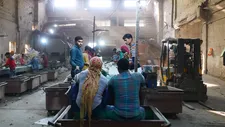 |
| Inside E-Waste Delhi Photo: Anuj Singh |
Alongside the message, there a romantic quality about the film, which is enhanced by Katerine Giguère’s beguiling cinematography.
“I knew I wanted to have a female cinematographer, just because I'm a woman filmmaker,” she says. “I'd been looking for a woman specifically to do the job and I found Katerine, and she really had this beautiful artistic way of telling stories in a very visual way. I liked that about her and we collaborated to set the look of the film. I knew I wanted to have big cinematic shots to show the amount of stuff that we're creating, but I also wanted to show the rust and the patina and get these very close, intimate shots of the things.
“I was telling her as she was filming that the objects themselves are kind of like characters in the film. So we tried to treat the objects as one would potentially treat a character and just to create a sense of attachment to the things and create an empathy towards them and an attachment towards them. She was really talented. We're actually nominated for an award for cinematography here in Canada.”
We discuss the shipbuilding section of the film, in which there's talk of the uniqueness of objects and how we produce many things that look exactly the same but when they get older they get scarred, and they have more personality.
“I love that,” she says. “But that's kind of how I feel about things. I think it's like there's little undercurrents of the things being also like people. People have a life cycle. People get wrinkles and scars and all this stuff that makes them more interesting. So I do see that sort of link between things and people, but it's so true, when something comes out of a factory, it has nothing, no personality. And how can you be attached to that thing? It's the life that you live with the thing that creates something that's beautiful.”
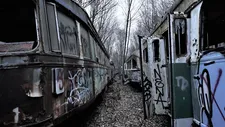 |
| Two rusty streetcars Photo: William Mackenzie |
I ask if making the film changed her perspective on any of the subjects it explores.
“Yeah. I think I'm much less interested in recycling. I think that recycling is a very much a band aid solution, and actually might even make us create more waste, because you're like, ‘Oh, it's going to be recycled, I can just do throw it away.’ We need to shift towards ideas of repair, circular economy, buying from companies that are making things better, that are making them to last. Companies that give a lifetime warranty to their stuff and will agree to take it back and repair it. And then upcycling, I think upcycling is just great. It's just so fun and creative.
“I think that there's a lot of creativity that can be brought to environmental problems that, and that's why it ended up just by happenstance that I had so many artists when I hadn't gone out intentionally to do that. I think it's really a good thing, because artists look at things differently. They look at problems differently and they come up with creative solutions.”
She’s now working on a film called Tough Old Broads, she tells me. “I'm following three female trailblazers, so like the first woman to do something in her field. They're all in their seventies now and they're incredibly vital, and still trying to change the world, and they’re amazing. So that's my next film. I'm just starting on it and it'll be a couple of years.”
























